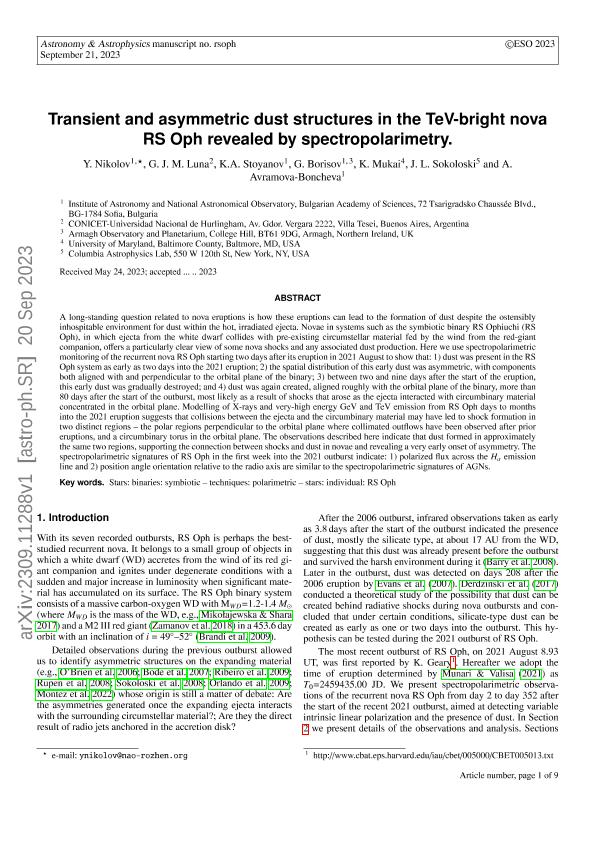Mostrar el registro sencillo del ítem
dc.contributor.author
Nikolov, Y.
dc.contributor.author
Luna, Gerardo Juan Manuel

dc.contributor.author
Stoyanov, K. A.
dc.contributor.author
Borisov, G.
dc.contributor.author
Mukai, K.
dc.contributor.author
Sokoloski, J. L.
dc.contributor.author
Avramova Boncheva, A.
dc.date.available
2023-12-20T16:02:42Z
dc.date.issued
2023-10
dc.identifier.citation
Nikolov, Y.; Luna, Gerardo Juan Manuel; Stoyanov, K. A.; Borisov, G.; Mukai, K.; et al.; Transient and asymmetric dust structures in the TeV-bright nova RS Oph revealed by spectropolarimetry; EDP Sciences; Astronomy and Astrophysics; 679; 10-2023; 1-9
dc.identifier.issn
0004-6361
dc.identifier.uri
http://hdl.handle.net/11336/220972
dc.description.abstract
A long-standing question related to nova eruptions is how these eruptions might lead to dust formation, despite the ostensibly inhospitable environment for dust within the hot, irradiated ejecta. In the novae of systems such as the symbiotic binary RS Ophiuchi (RS Oph), ejecta from the white dwarf collide with pre-existing circumstellar material fed by the wind from the red-giant companion, offering a particularly clear view of some nova shocks and any associated dust production. In this work, we use the spectropolarimetric monitoring of the recurrent nova RS Oph starting two days after its eruption in August 2021 to show that: 1) dust was present in the RS Oph system as early as two days into the 2021 eruption; 2) the spatial distribution of this early dust was asymmetric, with components both aligned with and perpendicular to the orbital plane of the binary; 3) between two and nine days after the start of the eruption, this early dust was gradually destroyed; and 4) dust was again created, aligned roughly with the orbital plane of the binary more than 80 days after the start of the outburst, most likely as a result of shocks that arose as the ejecta interacted with circumbinary material concentrated in the orbital plane. The modeling of X-rays and very-high-energy (GeV and TeV) emission from RS Oph days to months into the 2021 eruption suggests that collisions between the ejecta and the circumbinary material may have led to shock formation in two distinct regions: the polar regions perpendicular to the orbital plane, where collimated outflows have been observed after prior eruptions, and a circumbinary torus in the orbital plane. The observations described here indicate that dust formed in approximately the same two regions, supporting the connection between shocks and dust in novae and revealing a very early onset of asymmetry. The spectropolarimetric signatures of RS Oph in the first week into the 2021 outburst indicate: 1) polarized flux across the Hα emission line and 2) the position angle orientation relative to the radio axis is similar to what is seen from the spectropolarimetric signatures of active galactic nuclei (AGNs).
dc.format
application/pdf
dc.language.iso
eng
dc.publisher
EDP Sciences

dc.rights
info:eu-repo/semantics/openAccess
dc.rights.uri
https://creativecommons.org/licenses/by-nc-sa/2.5/ar/
dc.subject
BINARIES: SYMBIOTIC
dc.subject
STARS: INDIVIDUAL: RS OPH
dc.subject
TECHNIQUES: POLARIMETRIC
dc.subject.classification
Astronomía

dc.subject.classification
Ciencias Físicas

dc.subject.classification
CIENCIAS NATURALES Y EXACTAS

dc.title
Transient and asymmetric dust structures in the TeV-bright nova RS Oph revealed by spectropolarimetry
dc.type
info:eu-repo/semantics/article
dc.type
info:ar-repo/semantics/artículo
dc.type
info:eu-repo/semantics/publishedVersion
dc.date.updated
2023-12-19T23:19:14Z
dc.journal.volume
679
dc.journal.pagination
1-9
dc.journal.pais
Francia

dc.journal.ciudad
Paris
dc.description.fil
Fil: Nikolov, Y.. Bulgarian Academy Of Sciences; Bulgaria
dc.description.fil
Fil: Luna, Gerardo Juan Manuel. Universidad Nacional de Hurlingham.; Argentina. Consejo Nacional de Investigaciones Científicas y Técnicas; Argentina
dc.description.fil
Fil: Stoyanov, K. A.. Bulgarian Academy Of Sciences; Bulgaria
dc.description.fil
Fil: Borisov, G.. Bulgarian Academy Of Sciences; Bulgaria
dc.description.fil
Fil: Mukai, K.. University of Maryland; Estados Unidos
dc.description.fil
Fil: Sokoloski, J. L.. Columbia University; Estados Unidos
dc.description.fil
Fil: Avramova Boncheva, A.. Bulgarian Academy Of Sciences; Bulgaria
dc.journal.title
Astronomy and Astrophysics

dc.relation.alternativeid
info:eu-repo/semantics/altIdentifier/url/https://www.aanda.org/10.1051/0004-6361/202346997
dc.relation.alternativeid
info:eu-repo/semantics/altIdentifier/doi/http://dx.doi.org/10.1051/0004-6361/202346997
Archivos asociados
